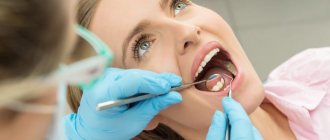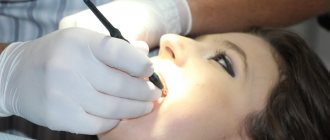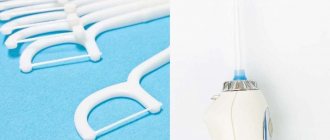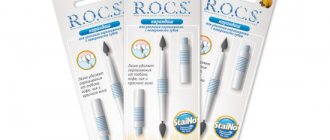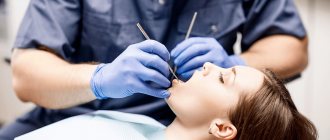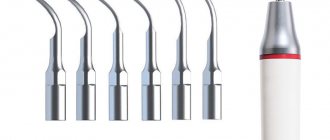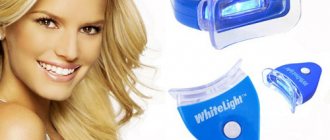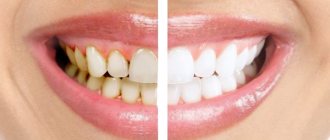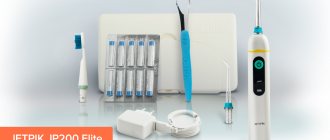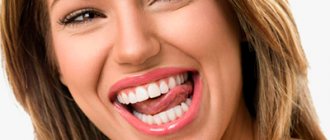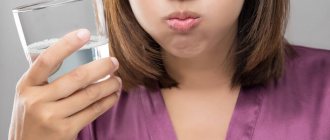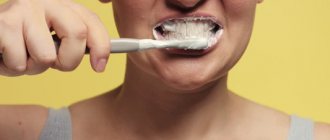What does proper oral hygiene give us?
- Prevention of caries.
Microbes and food particles stuck in the interdental spaces negatively affect the enamel, gradually destroying it. - Elimination of unpleasant odor.
The gases released by bacteria have a very unpleasant odor. In addition, food particles remaining in the mouth begin to decompose over time. As a result, bad breath appears, and thorough brushing of teeth perfectly freshens breath. - Remineralization of enamel.
Using strengthening toothpastes with a mineralizing effect will help strengthen the enamel and make teeth less susceptible to acid attack. - Healing and soft tissue massage.
The stability of teeth directly depends on the condition of the gums, and daily brushing prevents inflammatory processes in soft tissues and improves the overall condition of the oral cavity. - Prevention of diseases.
Microorganisms living in the oral cavity can cause ENT diseases, such as tonsillitis. Poor hygiene will contribute to this.
Periodontitis - forms, classification, photos
It is a consequence of pulp necrosis, which allows microorganisms to enter the hard and soft tissues of the jaw through the dental canal. The inflammatory process includes the peridontal ligament, cementum, root dentin together with the alveolar bone. Signs of periodontitis:
- the occurrence and intensification of pain when pressing on the tooth during the chewing process. There is a constant painful pulsation affecting half of the face;
- increased body temperature, feeling of weakness;
- swelling and tenderness of the gums in the affected area, as well as lymph nodes (mental and submandibular);
- discharge of pus from the root canal;
- facial asymmetry due to edema.
Consequences : lack of medical care leads to independent release of pus through the bones under the periosteum, as a result of which periodontitis becomes chronic.
Chronic periodontitis
A person may not be aware of the presence of the disease for a long time, since it occurs without the slightest symptoms. The reason to suspect the disease is the presence of a history of pain that was in the past, but gradually disappeared and does not remind of itself. A feature of chronic periodontitis is the melting of bone tissue around the affected tooth . Further development of the disease leads to loosening of the damaged tooth, as well as neighboring ones. Consequences: a common result is the loss of several teeth or granuloma .
Granuloma
It is a natural consequence of advanced periodontitis. The disease is marked by the spread of the inflammatory process, which is presented in the form of a small purulent nodule or sac in the area of the tooth root. Consequences: the infectious focus poses a serious danger to the body, as it acts as a catalyst for inflammation. At the initial stage, granulomas are characterized by practically asymptomatic progression. Severe pain gradually arises, which becomes more noticeable when pressing on the tooth or chewing solid food. Redness and swelling of the gums are noted, and tooth enamel becomes darker.
Root cyst
Lack of measures to treat granuloma leads to complications in the form of a root cyst. It forms at the top of the tooth root and is firmly attached to it. It looks like a round cavity located in the bone tissue, inside of which there is purulent contents. The root cyst grows slowly and imperceptibly, and therefore poses a significant danger. It can be visually determined only if it grows strongly, when protrusion of the bone is observed. Consequences: there is a possibility of the cyst growing into the maxillary sinus and nasal cavity. Displacement of teeth to the sides, as well as pathological fracture of the lower jaw.
Periostitis of the jaw bone, tooth
If treatment of root cysts and periodontitis was not carried out or was carried out in bad faith, then the likelihood of periostitis or inflammation of the periosteum sharply increases. The inflammatory process begins to emerge from the periodontal fissure and enters under the periosteum. Surgery is required, which involves making an incision in the mouth under anesthesia to release the pus. Consequences : failure to see a doctor in a timely manner carries the risk of an abscess.
Abscess
An abscess is a collection of purulent tissue in a confined space. The pus begins to put pressure on the root apex area, which leads to the tooth being pushed upward and possible destruction of the bone tissue in the affected area. If the abscess does not open for a long time, then the spread of pus to the periosteum, skin and mucous membrane begins. Consequences : severe and painful swelling occurs.
Phlegmon
It is considered one of the most dangerous forms of abscess. Cellulitis carries with it the risk of serious infection of the body, since infection and purulent accumulations from the swollen area enter the body. In fact, pus begins to spread throughout the surrounding tissues and can reach the neck and even the heart. The following symptoms are characteristic of phlegmon:
- swelling and tenderness of the soft tissue of the gums around the affected area;
- difficulty swallowing and opening the mouth;
- painful sensations behind the eyeball;
- deterioration of appetite and sleep;
- fever and weakness.
Consequences: the disease carries with it a significant risk of death! (we do not publish photos of phlegmon, copy and paste the word into a search engine to see the pictures).
Sinusitis
Inflammatory processes in the oral cavity (pulpitis, deep caries stage, cysts, periodontitis and others) aggravate the risk of single-gene sinusitis (sinusitis). It is caused by the penetration of infection from the affected tooth into the maxillary sinuses (we are mainly talking about infection in the upper molars and premolars, which are practically in contact with the maxillary sinuses). Initially, the infection enters only one maxillary sinus, then it spreads to the other. There is a possibility of getting into the sphenoid, frontal and other sinuses. Sinusitis manifests itself:
- severe headaches;
- swelling of the cheek;
- elevated temperature;
- thick mucous discharge of a purulent nature;
- pathological reaction to light.
If adequate treatment is not carried out in a timely manner, sinusitis can lead to the following consequences :
- transition to a chronic form;
- meningitis;
- sepsis, which is localized near the brain;
- purulent otitis;
- inflammation and swelling of nerve endings.
Tooth loss
Due to improper oral care and delays in seeking medical help, teeth decay and fall out. What are the consequences of losing teeth? Consequences :
- irreversible imbalance in the activity of the oral system. The absence of even one tooth disrupts the position of neighboring teeth; they do not hold so firmly in the gums, which can lead to their loss;
- a decrease in the efficiency of eating, as the degree of chewing and, accordingly, digestion of food deteriorates. A natural consequence is gastrointestinal diseases and metabolic disorders;
- curvature of the dentition, malocclusion, increased risk of diseases of the periodontal tissues;
- loss of aesthetic appeal (change in facial oval, sunken cheeks, visual unattractiveness due to missing teeth).
Bone atrophy
Atrophic processes in the maxillofacial region are a natural consequence of the absence of even one tooth. Its loss means the displacement of an entire row of teeth, a significant decrease in the volume of bone tissue. If atrophy is not stopped by building up bone tissue, then the lips and cheeks begin to “sink” into the oral cavity, and healthy teeth begin to move along the dentition due to loss of support. Consequences:
- the appearance of cosmetic facial defects (wrinkles, sunken lips, cheeks, etc.);
- deterioration of chewing function and the occurrence of gastrointestinal disorders;
- pathological changes in speech;
- displacement of the dentition, loss of healthy teeth.
Avoiding such unpleasant consequences is both easy and difficult. The main thing is to carefully observe oral hygiene and consult a dentist as soon as possible!
Why brush your teeth at night
At night, the human body rests, and its main systems go into “sleep” mode. The salivary gland is no exception, which is why in the morning we feel dry mouth and a great desire to drink. This happens because during sleep, saliva is practically not secreted, which means it does not perform its important functions:
- does not wash away food particles and bacteria from the surface of the teeth
- does not help regulate the pH level (acid-base balance) in the mouth
Didn't you brush your teeth before bed? This means that they are left with plaque accumulated during the day, food particles, as well as microorganisms that will happily feed on them until the morning. In such a comfortable environment, colonies of bacteria will quickly form. All night long they will release acids that destroy enamel, as well as gases, which cause bad breath in the morning. All this can be avoided by brushing your teeth thoroughly after your last meal.
If you have to choose between mandatory brushing of your teeth in the morning or before bed, then give preference to the latter option. During the day, saliva, solid foods and water will help you cope with plaque and bacteria, but at night your teeth become defenseless.
How to make home cleaning as effective as possible?
There are several ways to keep your teeth clean between office appointments.
- Use an ultrasonic brush (if there are no contraindications) or a regular electric brush with a timer. They are effective, but you must remember to change the attachments on time.
- If you use a regular brush, then use a moderately hard brush so that two-minute brushing does not cause bleeding gums.
- Brush your teeth after eating with floss (thread), thereby reducing the accumulation of plaque in the interdental spaces.
- Use a rinse aid with a plaque indicator. It shows how well you brush your teeth.
- Eating more fresh vegetables and fruits acts as a natural cleanser and keeps your gums strong and healthy.
More articles about dental health:
- Aesthetic dentistry: how to correct external defects of teeth
- Wisdom teeth: treat or remove?
What can happen if you brush your teeth irregularly or poorly?
- Caries will appear.
Plaque on teeth constantly attracts food particles and bacteria. If you don’t brush your teeth, microorganisms will feel so comfortable that already on the third day their number in the oral cavity will exceed the entire population of the Earth. All these bacteria will begin to secrete acids that will gradually destroy the enamel. This will allow the infection to penetrate into the tooth and tooth decay will begin. - The color of the teeth will change.
All foods, even green tea, contain dyes. Because of them, the plaque becomes pigmented, that is, stained, and the teeth darken as a result. Professional oral hygiene will help restore them to their natural shade. - Tartars form faster.
The soft film on the enamel mineralizes over time and turns into tartar. In fact, this is an inevitable process, since it is impossible to remove all plaque from the surface of each tooth even with the simultaneous use of a toothbrush, irrigator and floss. But those who brush their teeth thoroughly and regularly at home have less hard deposits and they form more slowly. - There will be a bad breath.
Microbes living in plaque emit gases with a very unpleasant odor. If you don’t remove biofilm from the surface of your teeth well, you can forget about fresh breath. - Your gums will become inflamed.
Gradually, tartar penetrates under the gums, and if they are not removed using ultrasound, then over time an inflammatory process will begin in the soft tissues - bleeding, pain and bad breath will appear. - Your teeth will become sensitive.
If you do not pay attention to gum inflammation, over time the soft tissues will cease to be elastic, they will begin to decline, and the teeth will appear longer because their roots will be exposed. At this point, you will have to exclude everything sweet, salty, sour, cold and hot from your diet, as tooth sensitivity will increase. - Teeth will lose stability.
Due to the severe inflammatory process, the tissue that holds the teeth in the socket is destroyed. They become unstable and may simply fall out over time.
Even incorrect movements when brushing your teeth and excessive pressure on the toothbrush can lead to abrasion of the enamel and the appearance of defects on it. Consult a hygienist to teach you the proper technique for brushing your teeth. This is an excellent prevention of caries and other oral diseases.
Tooth pulpitis - what is it?
Microorganisms + the toxins they release begin to penetrate into the dental pulp from the area damaged by caries. The body's response is increased blood flow in the pulp, increased pressure on the nerve fibers.
Acute pulpitis
It is characterized by acute toothache that occurs under the influence of cold/hot liquid or air. As soon as the irritant stops acting, the pain disappears. Consequences: lack of treatment leads to exacerbation of the disease and the occurrence of purulent pulpitis.
Purulent pulpitis
The disease is characterized by the presence of a purulent focus, which is located in the tooth cavity. The person begins to experience severe, unbearable pain, intensifying at night. Painful sensations are transmitted to the temporal region, ear or eye socket. Consequences: can lead to necrosis (death) of the pulp.
Chronic pulpitis
Untreated acute pulpitis leads to the development of a chronic condition. With chronic pulpitis, severe throbbing pain occurs when exposed to an irritant. As soon as the irritant goes away, the painful sensations gradually decrease. Chronic pulpitis requires prompt treatment, otherwise... Consequences : there is a high probability of a complication - periodontitis .
Use your finger
newsthump.com
As a last resort, just use your finger. This is the simplest, but actually effective advice from the Pennsylvania Center for Dental Implants and Periodontology.
Dentists using toothpaste and a finger is a good method for removing plaque in case of field conditions.
Simply apply a standard amount of toothpaste to your finger and rub it all over your teeth and gums as if you were actually using a toothbrush.
In this case, the following conditions must be observed:
1. Wash your hands thoroughly with soap;
2. Rinse your mouth to remove any food debris or debris.
see also
My head is splitting: how the pain can be related to teeth
Chew gum (sugar-free)
recyclingnation.com
Just like chewing vegetables, chewing gum can be a great way to remove plaque when brushing is not an option.
Chewing gum can dislodge any food particles remaining in the teeth and produce saliva, which is a natural disinfectant for rinsing the mouth and killing bacteria.
It is recommended to avoid sweets and use sugar-free chewing gum .
Teeth whitening methods
With the help of berries
Berries, in particular strawberries and wild strawberries, can not only be eaten, added to a pie or made into jam, but also used to whiten teeth. Both the juice and pulp of strawberries or strawberries can be used as a bleaching material. You need to rinse your mouth with the juice and then rub your teeth with the pulp.
Pros: An environmentally friendly and quite tasty way to whiten your teeth at home.
Disadvantages: however, do not forget that the juice of strawberries and wild strawberries contains acid, which corrodes the enamel of the teeth, so after this method of whitening you need to brush them with toothpaste.
Using an infusion of birch leaves
Pour boiling water over half a glass of birch leaves and let it brew for 20-25 minutes. At least 2 times a day, using a toothbrush soaked in this infusion, brush your teeth for 3 minutes.
Pros: environmentally friendly, completely free and easily accessible way to whiten your teeth at home.
Cons: the infusion contains substances that corrode tooth enamel, so after brushing you must rinse your mouth with water. In addition, whitening will not happen too quickly: the effect will be noticeable in a month at best.
Whitening with soda
You can rub your teeth with a cotton swab dipped in baking soda. You can also fill gauze with it and rub your teeth with a gauze swab - since the surface of the swab will be rough, the cleansing effect will be better. In addition, you can also rinse your mouth with baking soda.
Pros: teeth whitening this way will soon give quite noticeable results, in addition, this method is not at all expensive.
Cons: it is important to know that soda corrodes and thins the enamel of teeth, so frequent whitening with it will be very dangerous. Also, soda has a bad effect on the mucous membranes of the oral cavity and reduces acidity.
Using tree resin
You need to brush your teeth with it using a brush. Potassium hydroxide contained in the resin will promote bleaching.
Pros: environmentally friendly material that will help whiten your teeth at home quite quickly.
Cons: Tree resin cannot be used frequently. With prolonged use, it can damage the enamel and gums.
Whitening with activated carbon
Mash the activated carbon thoroughly to form a powder and apply to a wet brush. Whiten for 2-3 minutes, then rinse your mouth and brush your teeth again, this time with toothpaste.
Pros: this teeth whitening system is easily accessible, because activated carbon is available in any pharmacy and is quite inexpensive.
Cons: this method is not suitable for those who set out to whiten their teeth in the shortest possible time. In addition, if the activated carbon is not crushed well enough, you risk scratching your teeth enamel.
Using whitening pastes
This is the least hassle-free way to whiten your teeth at home. There is no need to grind, rub or insist on anything: just apply the whitening paste to the brush and clean the surface of the teeth. Your dentist will help you decide on the choice of whitening paste.
Electric toothbrushes are more effective than manual ones
Pros: Teeth whitening methods that use whitening pastes are the safest for tooth enamel.
Disadvantages: this is an ineffective method, and this type of whitening cannot be used for more than one month, otherwise the tooth enamel will begin to deteriorate.
Whitening gels
This is a relatively new method that will help whiten your teeth at home. To use it, consultation or assistance from a dentist is required. The doctor will help you choose the right gel and tell you how to use it for whitening. The gel can be simply applied to the surface of the teeth, or it can be whitened using a special tray, which the doctor will make from an impression taken from your own teeth.
Pros: the method is quite effective, giving visible results.
Cons: When using whitening with a tray, you need to be careful with hydrogen peroxide. It is best to carry out such whitening after consultation with a dentist.
How much does it cost to brush your teeth too often?
More than twice. Dentists recommend not to get carried away with brushing your teeth for several reasons. The first is that the bristles of a toothbrush can mechanically damage the enamel, which leads to microcracks. In the future, this leads to the destruction of the tooth as a whole. Often, this happens after using a brush that is too hard. The enamel wears away, leaving the tooth even without natural protection. The second reason is that the active substances in toothpaste increase the sensitivity of the enamel, irritating the gums and mucous membranes. As a result, the gums swell and bleed more often.
If frequent brushing of your teeth is a method of getting rid of an unpleasant aftertaste after eating, then you need to get into the habit of using mouth rinse or chewing gum. Acidic foods weaken enamel—another reason to refrain from brushing your teeth frequently.
Use dental floss and mouthwash
Dmytro Panchenko/Thinkstock
If you forgot your toothbrush and don’t have any toothpaste, but have dental floss and mouthwash , you can brush your teeth no worse than at home with your usual hygiene products.
1. Use dental floss to remove hard pieces of food stuck between your teeth;
2. Rinse your mouth thoroughly with water;
3. Finally, rinse your mouth with mouthwash to kill any remaining bacteria.
Yes, of course, we understand that the likelihood that you forgot your toothbrush, but put dental floss and mouthwash in your bag, is very small, but this is perhaps the best option (we recommend always having this “gentleman’s” kit with you) in his bag).
Eating vegetables
summerhillmarket.com
Oddly enough, some dentists recommend eating crunchy vegetables instead of regular brushing.
“Fibrous vegetables can act like a brush. When you eat them, biting and chewing can remove food particles and clean your teeth, explain experts at Grace & Leedy Dentistry
In particular, you can use a celery stalk as an alternative toothbrush. You can either simply eat it (if you don’t have toothpaste), or after biting it, tear off the edge and use the stem as a natural toothbrush, applying toothpaste to it.
